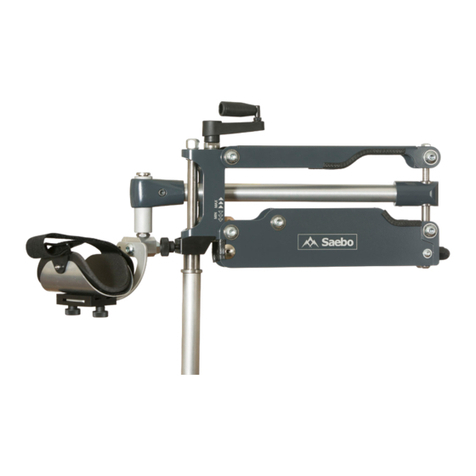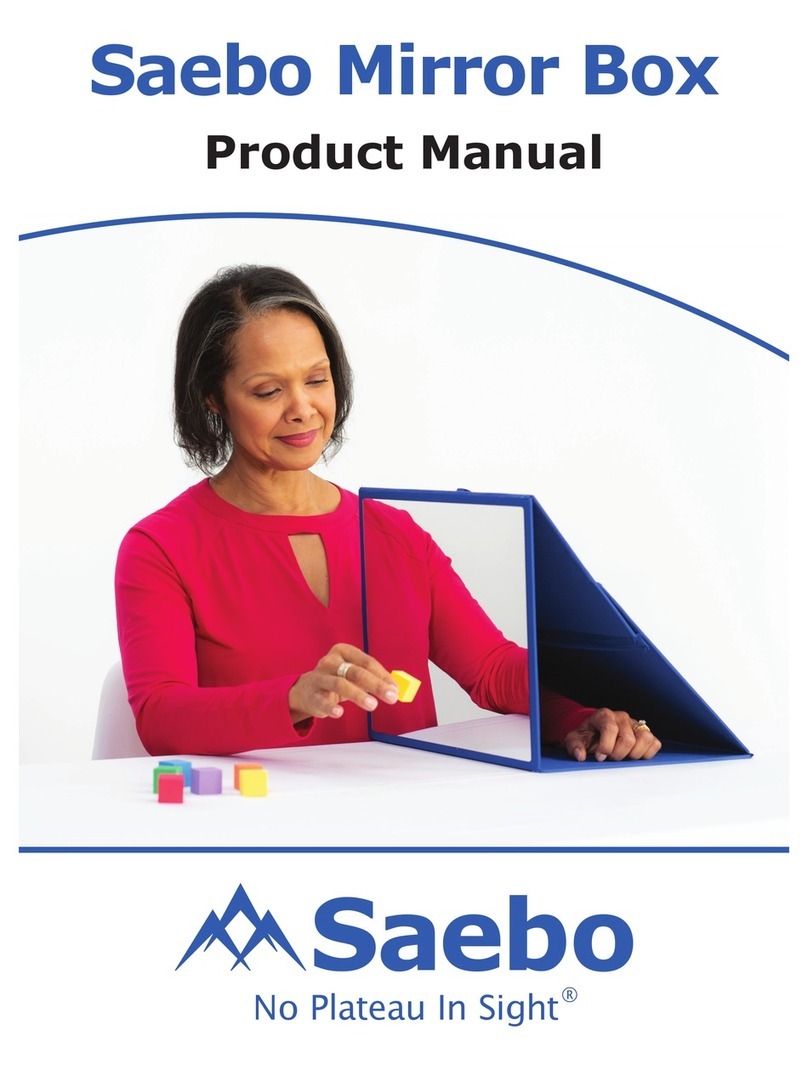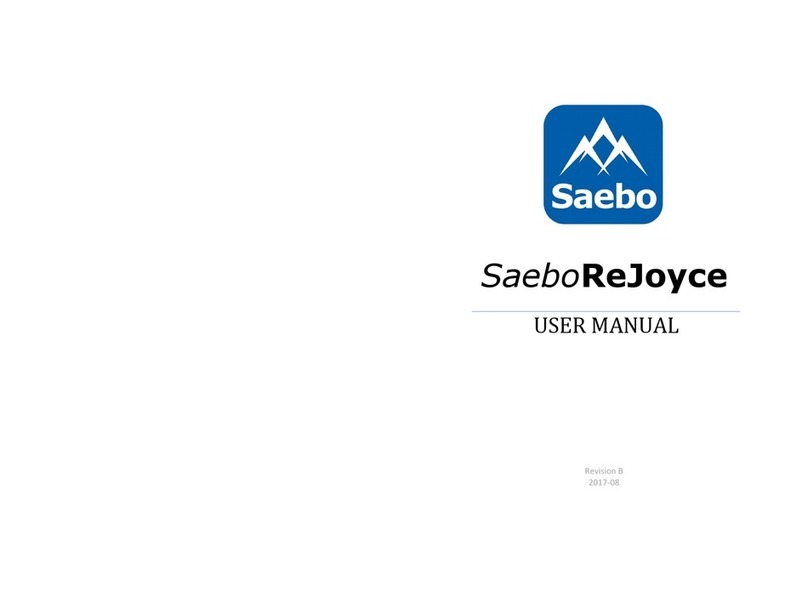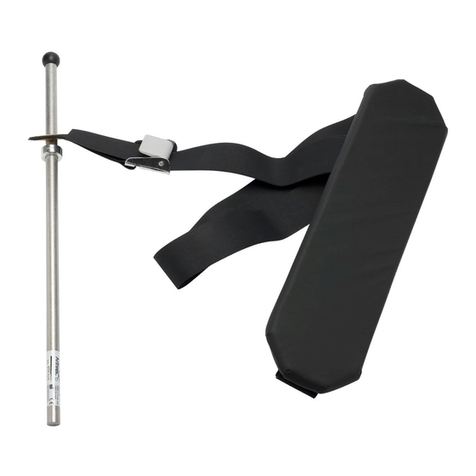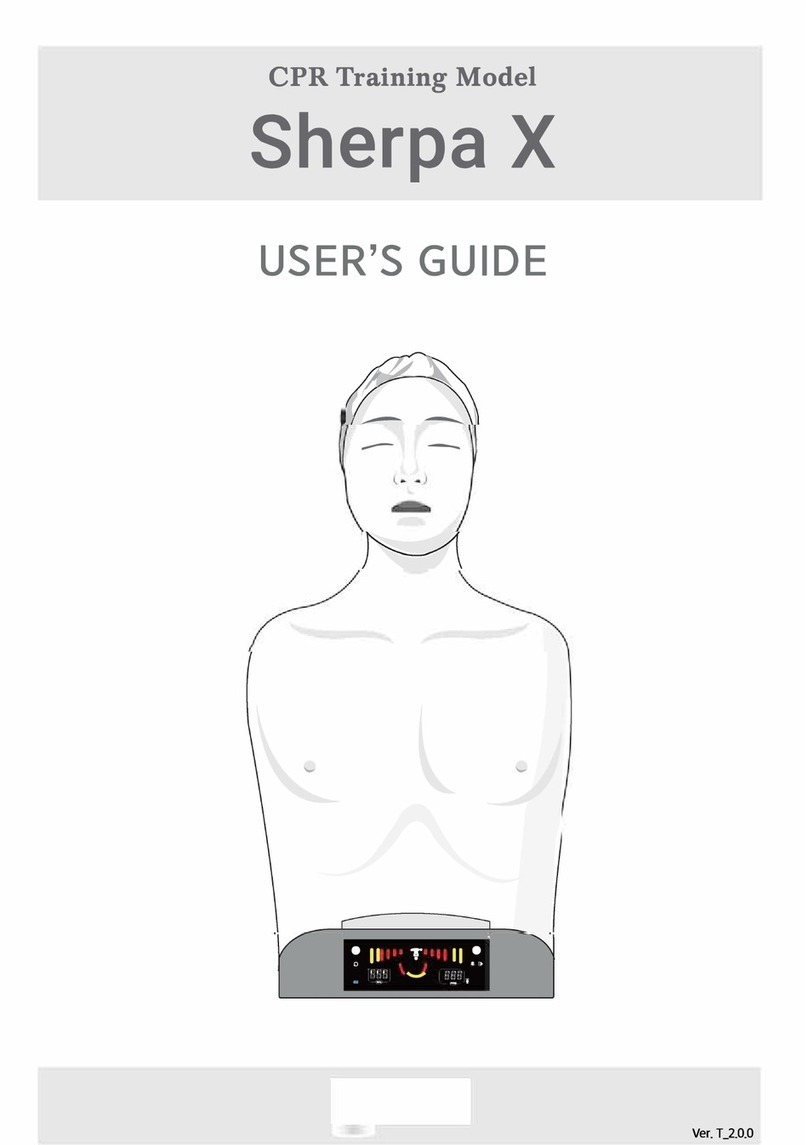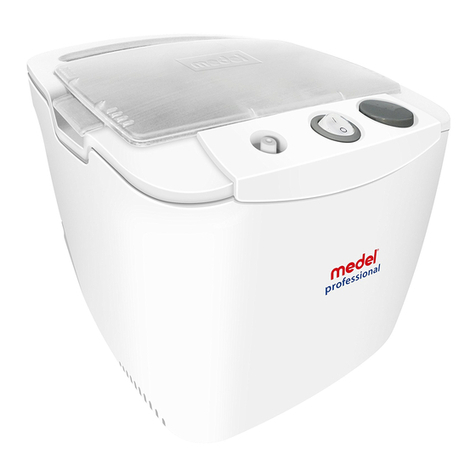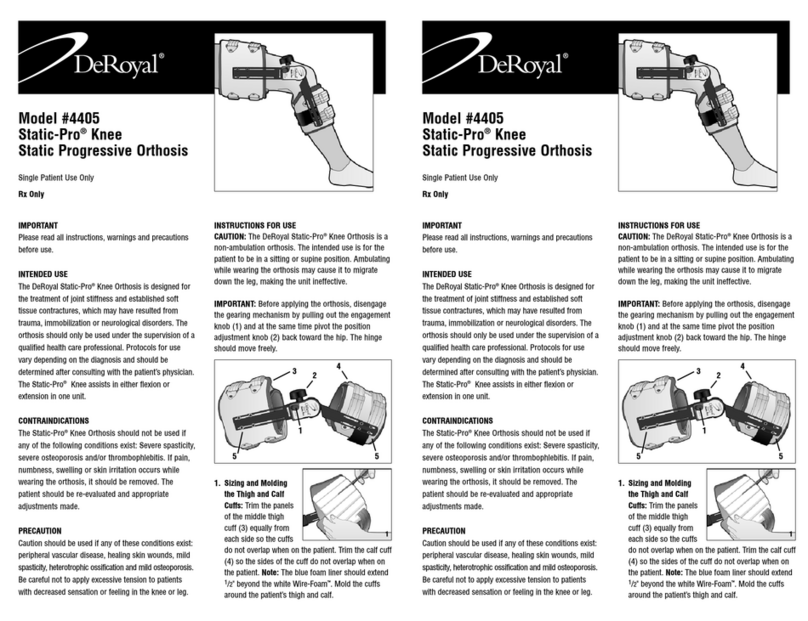Saebo SaeboGlide User manual

SaeboGlide
www.Saebo.com
(888) 284-5433
Challenging you throughout your recovery

SaeboGlide
(PATENTED)
BY
SAEBO, INC.
Congratulations, you have taken the first step in maximizing your rehab potential. A well-developed
patient-specific home exercise program is essential for optimum recovery. After all, you will be working
alone at home far more than with your therapist.
The SaeboGlide is a versatile piece of exercise equipment that can be used at home independently. It
can be used in a sitting, standing, or lying position. You can track your progress while performing our
recommended exercise program that will challenge you throughout all stages of your recovery.
This instructional manual describes an in-depth comprehensive program. Soon, you will learn how to
exercise your arm at your current level of function. Also, you will know when and how to advance your
exercises when they no longer challenge you. The exercise program consists of three sections: (1)
stretching, (2) bilateral exercises (both arms), and (3) level I and level II gliding exercises.
WHY THE SAEBOGLIDE WORKS:
The SaeboGlide offers a way to exercise your involved arm by using the gliding sleeve. Following
placement of your hand onto the gliding sleeve, the distal support will allow you to perform various
controlled upper extremity exercises that are appropriate for your strength level.
INDICATIONS:
1. Stroke
2. Traumatic Brain Injury (TBI)
3. Individuals suffering from hemiparesis
PRECAUTIONS:
1. All stretches and exercises should be performed pain-free. If you experience any pain
during the stretches and/or exercises, stop immediately and contact a health care
professional before resuming.
2. Do not give the SaeboGlide or Plus version to unsupervised children.
3. Do not use the SaeboGlide or Plus version if you have allergies to rubber or plastic
products.
4. Caregiver assistance is recommended for individuals with cognitive impairments and severe
spasticity.
5. Do not use the SaeboGlide or Plus version inside any monoplace hyperbaric
chamber.
MAINTENANCE OF THE SAEBOGLIDE:
The SaeboGlide should be cleaned monthly with a damp cloth. Avoid chemicals/abrasives for cleaning
which may damage and decrease the performance of the SaeboGlide. Also, it is recommended that your
hands are clean prior to using, as residue on the pole will decrease performance. Do not leave your
SaeboGlide in the sun or near extreme heat, this will affect the properties of the plastic in an adverse
way decreasing performance.
CONTACT INFORMATION:
Saebo, Inc. PHONE: 888-284-5433
Six LakePointe Plaza EMAIL: sales@saebo.com
2725 Water Ridge Parkway WEBSITE: www.saebo.com
Suite 320
Charlotte, NC 28217

SaeboGlide
PARTS:
(A) BOTTOM RUBBER TIP: is used to stabilize the end of the pole against a surface (i.e., floor, wall,
furniture etc…) while exercising.
(B) POLE: is positioned at varying angles while exercising to decrease or increase resistance.
(C) O-RINGS: are used during exercises to set your target goals. They can also be positioned on
both sides of sleeve to keep it from moving during bilateral exercises.
(D) SLEEVE: is grasped with the involved hand during exercises.
(E) TOP GRIP: can be grasped with the uninvolved hand to stabilize the pole during exercises.
*NOTE: If you purchased the SaeboGlide Plus, refer to the “SaeboGlide Plus” section located in the back of the
manual that explains the hand strapping system.
GETTING STARTED: It is important to have a good understanding of how to effectively use your
SaeboGlide to fully maximize its potential. To start you need to determine the following:
1. What is my starting point?
2. How do I effectively exercise at my current level?
3. When and how do I advance my exercises?
1.) DETERMINING YOUR STARTING POINT: It is important to determine what level of strength you
currently exhibit for each exercise. The SaeboGlide is designed to allow you to progress from level I
(poor/fair strength) to level II (fair/good strength). It is recommended that you attempt all level I
exercises first. If you can complete some or all of the level I exercises without difficulty then attempt the
level II exercises. Performing the exercises without difficulty means performing 3 sets of 10 repetitions of
the specified exercise from start to end position. It is common for people to be able to perform a
combination of level I and level II exercises. Therefore, determine the specific exercises you can and
cannot perform. The exercises you can perform will be your starting point and the exercises you cannot
perform will be your projected exercise goals. Your program mix will depend on your individual ability to
perform each exercise. Your starting program may consist of:
1. Only a few level I exercises.
2. All level I exercise.
3. A combination of level I and level II exercises.
4. All level II exercises.

**NOTE: If the level I exercises are performed without difficulty, but you’re unable to advance to the level
II exercises, see “Advancing your exercise program #1, 2, 4 & 5” below for suggestions.
2) EFFECTIVELY EXERCISING AT YOUR CURRENT LEVEL:Some of the recommended stretches and
exercises featured below may not be right for you. It is recommended that you contact your physician to
determine if the program is appropriate for your needs. It is recommended that you perform the
suggested stretches and bilateral exercises prior to your level I and level II strengthening program. The
complete SaeboGlide program can be performed two times per day. If you are unable to complete your
program two times per day, perform as many as you can and slowly progress to two times per day. Each
exercise should be performed 3 sets of 10 repetitions. The repetitions can be increased or decreased
depending on your individual ability. If you are still having a difficult time getting started talk to your
physician for a possible referral to a local therapist to set you up with a home exercise program with your
SaeboGlide.
3) ADVANCING YOUR EXERCISE PROGRAM: It is time to advance your exercises when you can perform 3
sets of 10 repetitions without difficulty. There are 5 ways to advance:
1. Increase the number of repetitions (i.e., Instead of 3 sets of 10 reps, try 3 sets of 15 reps). This is
used when advancing at level I and level II.
2. Increase the angle of the pole to facilitate advancing from level I to level II. Raising the pole in a
more vertical position will result in an increase in resistance.
3. Use a wrist weight on your involved wrist. This is used when advancing the level II exercises.
4. To advance bilateral exercises, you can do the following:
•Transition from a lying position to a seated or standing position.
•Position your hands further apart on the pole.
•Attach a wrist weight to the pole between your hands.
•During the lowering phase of the exercise, stop at various points and hold
for a count of 5. The longer you hold the more difficult the exercise.
•During the lowering phase of the exercise, try to lower the pole as slowly and
as smoothly as you can. This will make the exercise more difficult.
5. Position the o-rings further apart to increase the range of motion for each exercise.
THE SAEBOGLIDE EXERCISE PROGRAM: Once you have read and understood the “getting
started” section, it is time to begin your program. It is recommended that you perform your
program in the following sequence for maximum results:
1. STRETCHES
2. BILATERAL EXERCISES
3. LEVEL I AND/OR LEVEL II EXERCISES

STRETCHING PROGRAM
A common problem following a stroke is experiencing decreased range of motion in the involved upper
extremity. This may happen as a result of poor compliance with a home exercise program, increased
tone, and poor posture just to name a few. The outcome is the same, limited and painful movement. It is
highly recommended that you always perform the appropriate stretches before using the SaeboGlide to
maximize your results. Below are recommended basic stretches to do before using the SaeboGlide. You
may have already been instructed on a comprehensive stretching program for your involved arm. If that
is the case, use your current program before using the SaeboGlide.
TIP:
Maximizing and maintaining the range of motion in your involved upper extremity is extremely important.
The stretches can be done several times during the day and not just before using the SaeboGlide.
1) WRIST AND FINGER EXTENSION:
START POSTION:
Place your involved hand and fingers as flat as possible
on a firm surface. Use your good hand to assist if
necessary.
END POSITION:
Straighten your involved elbow by using your good hand.
Lean your body forward until you feel a pain-free stretch
in the wrist. Hold for 10 seconds and repeat 5 times.
2) RADIAL & ULNAR DEVIATION:
START POSITION: With your arms at your side and elbows bent, interlock your fingers and grasp both hands
together.
END POSITION (A): Without moving your elbows, raise both hands upward. Hold for 10 seconds and repeat 5
times.
END POSITION (B): Without moving your elbows, push both hands toward the floor. Hold for 10 seconds and
repeat 5 times.
START POSITION END POSITION
START POSITION END POSITION (A) END POSITION (B)

3.) SUPINATION:
START POSITION:
Position your involved arm on your thigh with your elbow
bent. With your good hand, grasp your involved forearm
just above the wrist.
END POSITION:
Turn your involved forearm over so your palm is facing
directly up. Once you feel a pain-free stretch, hold for 10
seconds and repeat 5 times.
4.) ELBOW EXTENSION:
START POSITION:
While sitting at the edge of a chair, grasp both hands
together by interlocking your fingers.
END POSITION:
Straighten your involved elbow by pushing both hands
toward the floor. Once you feel a stretch, hold for 10
seconds and repeat 5 times.
5.) SHOULDER FLEXION:
START POSITION:
While Lying down on your back, grasp both hands
together by interlocking your fingers. Keep your elbows
as straight as possible.
END POSITION:
Raise both arms up over your head as far as possible.
When you feel a pain-free stretch, hold for 10 seconds
and repeat 5 times. Avoid stretching near a wall so it
does not limit you from reaching the full range of
motion.
6.) EXTERNAL ROTATION:
START POSITION:
While sitting in a chair directly next to a table, position
your involved arm on the table as shown in the start
position.
END POSITION:
Keeping your shoulders square, slowly bend forward at
the waist until you feel a pain-free stretch at the
shoulder. Hold for 10 seconds and repeat 5 times. This
is a common location for tightness.
START POSITION END POSITION
START POSITION END POSITION
START POSITION END POSITION
START POSITION END POSITION

BILATERAL EXERCISES
Performing bilateral exercises are an excellent way to not only improve and maintain flexibility, but also
increase strength and endurance. Listed below are several exercises that are recommended regardless
of your strength level. Refer to: “Advancing your exercises # 4” for ways to upgrade your bilateral
exercise program.
TIPS:
If the side of the pole your involved hand is on dips lower than the uninvolved side, try moving your
hands closer together. This will make the exercise easier. The object is to keep both ends of the pole
parallel to the floor.
If your grip is poor and you are unable to close your hand around the pole, try placing your hand onto
the sleeve. Position the o-rings on both sides of the sleeve so your hand does not move laterally.
1.) CHEST PRESS:
START POSITION:
While lying on your back, position the pole across your
chest. Grab the pole with both hands shoulder width
apart.
END POSITION:
Raise the pole toward the ceiling as far as you can. Try
to straighten both elbows. Return the pole slowly to
your chest by bending both elbows. Complete 3 sets of
10 repetitions.
2.) SHOULDER FLEXION/EXTENSION:
START POSITION:
While lying on your back, position the pole across your
lap. Grab the pole with both hands shoulder width
apart.
END POSITION:
Keeping your elbows as straight as possible, raise the
pole up over your head as far as you can pain-free.
Complete 3 sets of 10 reps.
3.) ELBOW FLEXION/EXTENSION:
START POSITION:
While sitting in a chair, grab the pole with both hands
shoulder width apart. If you are unable to grip the pole
with your palms up, you can do this with the palms
facing down. If this is the case, work on stretch #3.
END POSITION:
Bend both elbows up as far as possible, and then
return the pole to the start position. Complete 3 sets of
10 reps.
START POSITION END POSITION
START POSITION END POSITION
START POSITION END POSITION

LEVEL I PROGRAM
As previously mentioned, all level I exercises were designed for people with poor/fair strength. It is
recommended that you perform all level I exercises first. Once you complete some or all of level I
exercises without difficulty, move on to the level II program and/or see “Advancing your exercise
program # 1, 2, 4& 5” for more ways to challenge yourself.
1) HORIZONTAL ABDUCTION/ADDUCTION (LYING):
START POSITION:
While lying on your back, position the pole across your
chest. Place your good hand on the pole and your
affected hand on the gliding sleeve. Keeping both
elbows as straight as possible and hands shoulder
width apart raise the pole toward the ceiling. If
possible, position the end of the pole against the wall
so it does not move during the exercise.
END POSITION:
Move the sleeve toward the good hand. Return the
sleeve slowly to the starting position. Complete 3 sets
of 10 reps.
2) SHOULDER FLEXION/EXTENSION:
START POSITION:
While lying on your good side, position the bottom
portion of the pole between your knees. Hold the top
portion of the pole with your good hand. Try to keep the
pole parallel with your body. Position your affected
hand on the gliding sleeve toward the bottom portion
of the pole.
END POSITION:
Move the sleeve toward the top of the pole as far as
you can pain-free. Return the sleeve slowly to the
bottom. Complete 3 sets of 10 reps.
3) PASSIVE SHOULDER FLEXION:
START POSITION:
While sitting in a chair, place the pole on the floor
between your feet in an upright position. Place your
affected hand on the gliding sleeve. Position your good
hand around the affected hand. If possible, have
someone hold the top of the pole so it does not move.
END POSITION:
With both arms, move the sleeve up as far as you can
pain-free. Try to have the affected arm help as much as
possible. Return the sleeve slowly to the bottom.
Complete 3 sets of 10 reps.
START POSITION END POSITION
START POSITION END POSITION
START POSITION END POSITION

4) ELBOW FLEXION/EXTENSION:
START POSITION:
While lying on your good side, position the bottom
portion of the pole between your knees. Hold the top
portion of the pole with your good hand. Try to keep the
pole parallel with your body. Position your affected
hand on the gliding sleeve toward the bottom portion
of the pole.
END POSITION:
Bend your affected elbow to allow the sleeve to move
toward the top of the pole. Make sure your affected
shoulder does not move. Return the sleeve toward the
bottom portion of the pole by trying to straighten your
affected elbow. Complete 3 sets of 10 reps.
5) PASSIVE ELBOW FLEXION/EXTENSION:
START POSITION:
While sitting in a chair, place the pole on an angle so
that the top portion of the pole is resting over your
shoulder and the bottom is on the floor near your foot.
Place your affected hand on the gliding sleeve. Position
your good hand around the affected hand. If possible,
have someone hold the top of the pole so it does not
move.
END POSITION:
With both arms move the sleeve toward the top of the
pole. Return the sleeve toward the bottom portion of
the pole by trying to straighten your affected elbow.
Have the affected arm help as much as possible.
Complete 3 sets of 10 reps.
6) WRIST FLEXION/EXTENSION:
START POSITION:
While sitting in a chair, place the pole on the floor
between your feet in an upright position. Place your
affected hand on the gliding sleeve. Hold the top
portion of the pole with the good hand.
END POSITION:
Slowly move your affected hand backward. Try not to
move your shoulder and/or elbow. Return the sleeve
forward as shown in the start position. Complete 3 sets
of 10 reps.
START POSITION END POSITION
START POSITION END POSITION
START POSITION END POSITION

LEVEL II PROGRAM
The level II program was designed for people who exhibit fair/good strength. If you can complete the
level II exercises without difficulty, refer to “Advancing your exercise program # 1, 3, & 5” for additional
ways to challenge yourself.
1) HORIZONTAL ABDUCTION/ADDUCTION (SITTING):
START POSITION:
While sitting in a chair, position your good hand on the
pole and your affected hand on the gliding sleeve.
Keeping both elbows as straight as possible and hands
shoulder width apart raise the pole to shoulder level. If
possible, position the end of the pole against the wall
so it does not move during exercises.
END POSITION:
Move the sleeve toward the good hand. Return the
sleeve slowly to the start position. Complete 3 sets of
10 reps.
2) SHOULDER FLEXION:
START POSITION:
While sitting in a chair, place the pole on the floor
between your feet in an upright position. Position your
affected hand on the gliding sleeve. Hold the top
portion of the pole with the good hand.
END POSITION:
Raise the sleeve as high as possible pain-free. Lower
the sleeve slowly. Complete 3 sets of 10 reps.
3) SCAPTION:
START POSITION:
While sitting in a chair, place the pole in an upright
position on the floor to the side of your affected foot.
Position your affected hand onto the gliding sleeve.
Hold the pole just below the sleeve with your good
hand.
END POSITION:
Raise the sleeve as high as possible pain-free. Lower
the sleeve slowly. Complete 3 sets of 10 reps.
START POSITION END POSITION
START POSITION END POSITION
START POSITION END POSITION

4) EXTERNAL ROTATION:
START POSITION:
While sitting in a chair, position pole horizontally across
your chest. If possible, position the end of the pole
against the wall. Place your affected hand on the
sleeve. Hold the other end of pole with your good hand.
Keep both elbows bent and hands shoulder width
apart.
END POSITION:
Move the sleeve away from your body without moving
your shoulder or elbow. Return the sleeve to the start
position. Complete 3 sets of 10 reps.
5) ELBOW FLEXION/EXTENSION:
START POSITION:
While sitting in a chair, place the pole on an angle so
that the top portion of the pole is resting over your
shoulder and the bottom is on the floor near your foot.
Position your affected hand onto the gliding sleeve
toward the bottom portion of the pole. Hold the top
portion of the pole with your good hand.
END POSITION:
Bend your affected elbow so the sleeve moves toward
the top of the pole. Make sure the affected shoulder
does not move. Return the sleeve toward the bottom
portion of the pole by trying to straighten your affected
elbow. Complete 3 sets of 10 reps.
6) FOREARM PRONATION/SUPINATION:
START POSITION:
While sitting in a chair, place the pole between your
body and your affected elbow. Position your affected
hand on the gliding sleeve so your palm is facing
upward.
END POSITION:
Rotate your forearm so your palm is facing toward the
floor. Return to the start position. Complete 3 sets of
10 reps.
START POSITION END POSITION
START POSITION END POSITION
START POSITION END POSITION

7) WRIST FLEXION/EXTENSION:
START POSITION:
While sitting in a chair, place the pole across your
knees. Position the affected hand on the sleeve. Hold
the other end of the pole with your good hand.
END POSITION:
Slowly move your affected hand backward. Try not to
move your shoulder and/or elbow. Return the sleeve
forward as shown in the start position. Complete 3 sets
of 10 reps.
CLINICAL USES FOR THE HEMI-GLIDE
FIGURE 1 FIGURE 2 FIGURE 3
1. Adding a wrist weight to increase resistance.
2. Applying electric stimulation to facilitate and maximize range of motion and strength.
3. Using mechanical vibration to increase strength and retard atrophy.
TIPS BEFORE STARTING
•When performing your exercises, remember that the quality of movement is more important
than the quantity of movement.
•Perform the exercises with slow to moderate speed.
•Rest for 1 to 2 minutes between each set of repetitions.
•The exercises recommended above are just a few of the many that can be performed. Be
creative and have fun.
•When learning the stretches and exercises, it is recommended that you practice a few a day
until you feel comfortable.
On the next page is a pre-printed exercise log for your convenience. You can track your progress and
develop a weekly program. In addition, the log can be provided to your health care professional to assist
you in developing the right program for you. It is recommended that you make duplicate copies of the
exercise log for weekly use.
START POSITION END POSITION

SAEBOGLIDE PROGRESSIVE HOME EXERCISE
PROGRAM
PATIENT NAME: WEEK#:
THERAPIST: DATE:
PRECAUTIONS:
MONDAY TUESDAY WEDNESDAY
THURSDAY
FRIDAY SATURDAY SUNDAY SETS/
REPS
STRETCHES
1)Wrist Extension
2)Radial/Ulnar Deviation
3)Supination
4)Elbow Extension
5)Shoulder Flexion
6)External Rotation
BILATERAL
EXERCISES
1)ChestPress
2)Shoulder Flex/Ext
3)ElbowFlex/Ext
LEVEL I
1)Horizontal Abd/Add
2)Shoulder Flex/Ext
3)PassiveShldFlexion
4)ElbowFlex/Ext
5)Passive Elbow Flexion
6)WristFlex/Ext
LEVEL II
1) Horizontal Abd/Add
2) Shoulder Flexion
3) Scaption
4) External Rotation
5)ElbowFlex/Ext
6)ForearmPron/Sup
7)WristFlex/Ext
If you’re having any problems with the exercise program, feel free to contact us at our website or call us at
1-(888)-28-GLIDE for additional tips.

SAEBOGLIDE PLUS
The SaeboGlide hand strap is a specially designed strapping system for individuals who have
decreased gripping ability. The steps below describe how to put on the hand strap as well as how to
attach it to your SaeboGlide.
1) Open the hand strap and
place on your lap or flat surface
with the soft Velcro side of
lar
g
e strap facin
g
up.
2) Place your affected hand
(palm side down) on top of the
center strip so the wrist strap is
j
ust below the hand.
3) Pull small left strap over
hand and fasten with small
right strap (adjust for snug
fit).
4) Pull large left strap over
wrist and fasten with large right
strap (adjust for snug fit).
5) Thread the SaeboGlide pole through the
loop on the palm side and position directly in
the center of the gliding sleeve. Place the O-
rings on both sides of the sleeve so it does not
move.
6) Tighten the hand strap by pulling
towards you. Secure the strap by folding
over onto the Velcro.
The small strap can be adjusted
to accommodate hand size. To
adjust, move the strap closer or
further from the wrist
until it is in the position shown
here.

Tip:
For individuals who have no or poor arm/hand function, try the following:
Precaution: If your hand is visibly swollen, avoid using the hand strap for more than 15-20 minutes at a
time. People with fragile skin may wish to use a cotton wristband under the wrist strap to avoid irritation.
Please contact us if you are having difficulty applying the hand strap to your SaeboGlide. We will
be happy to assist you.
5.) Secure the strap by folding over onto
the Velcro.
3.) Place the O-rings on
both sides of the sleeve so it
does not move. Position the
loop directly in the center of
the gliding sleeve.
4.) Tighten the hand strap
by pulling towards you.
1.) Once the hand strap is
attached to your hand,
adjust the loop on palm side
so it will fit over the pole.
2.) Grab the involved wrist
with your good hand and
position the loop over the
top of the pole.
Table of contents
Other Saebo Medical Equipment manuals
Popular Medical Equipment manuals by other brands
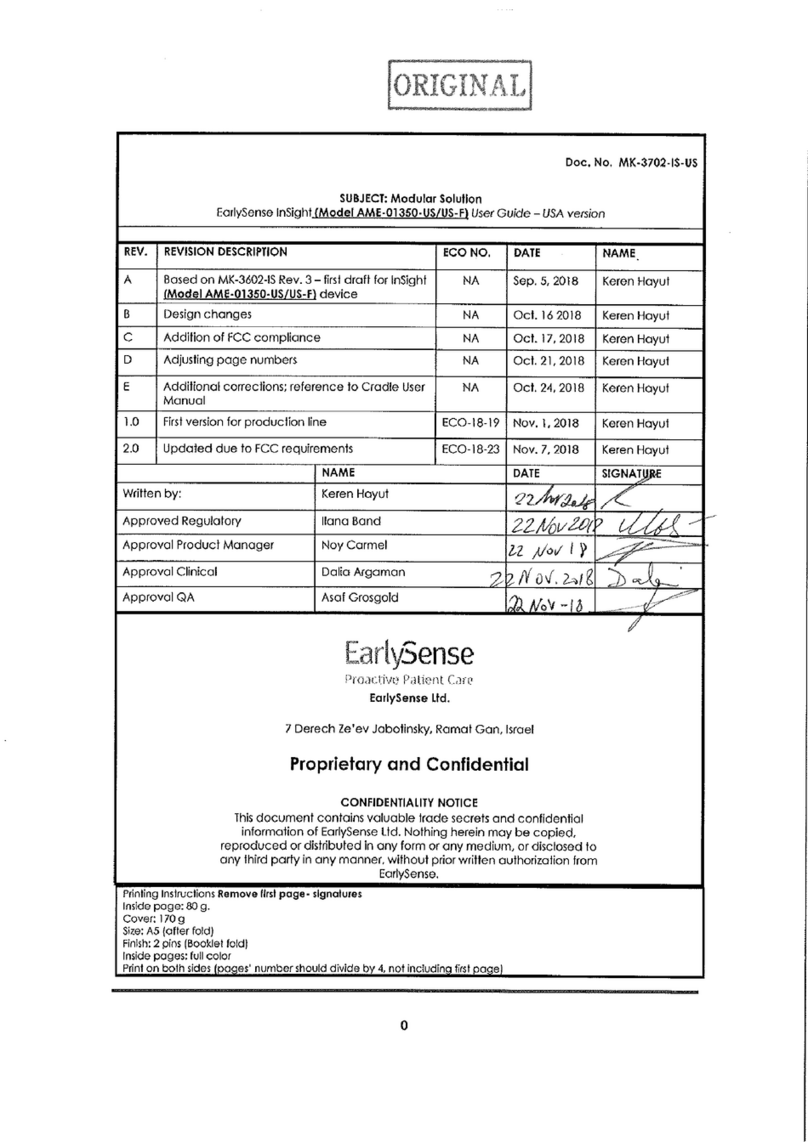
EarlySense
EarlySense InSight AME-01350-US user guide

NRS Healthcare
NRS Healthcare P23117 User instructions

Pelsis
Pelsis CURTIS DYNA-FOG HURRICANE ES HESUK user manual
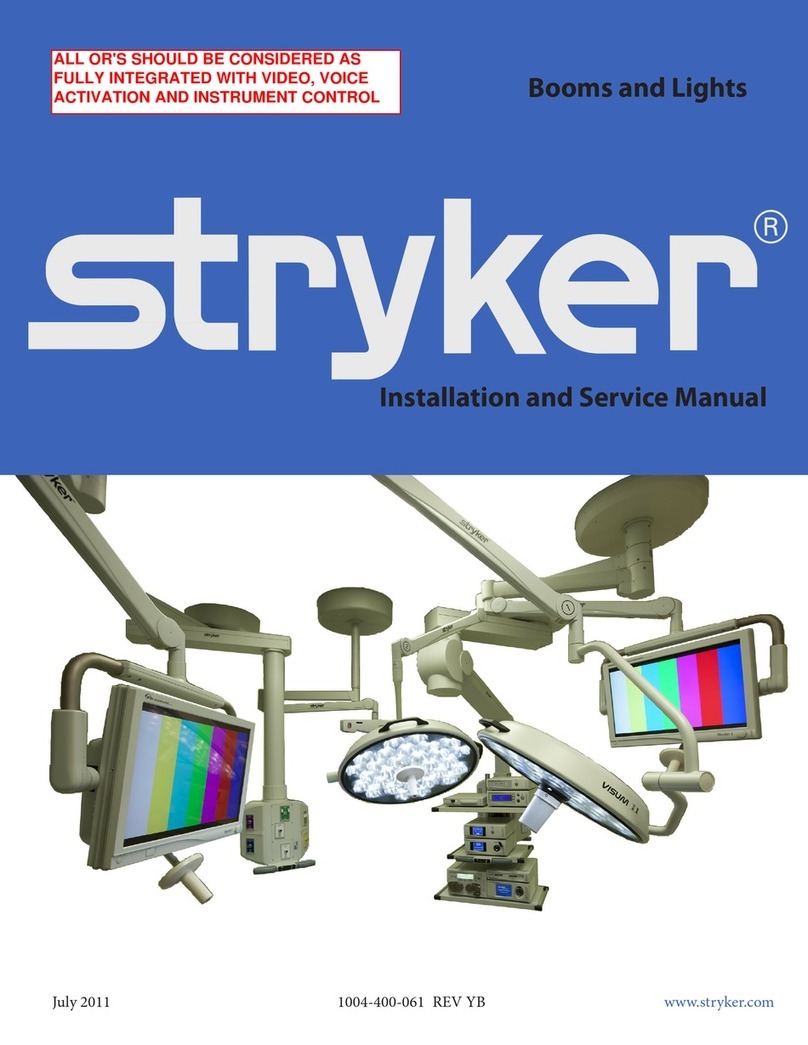
Stryker
Stryker Visum 450 Installation and service manual
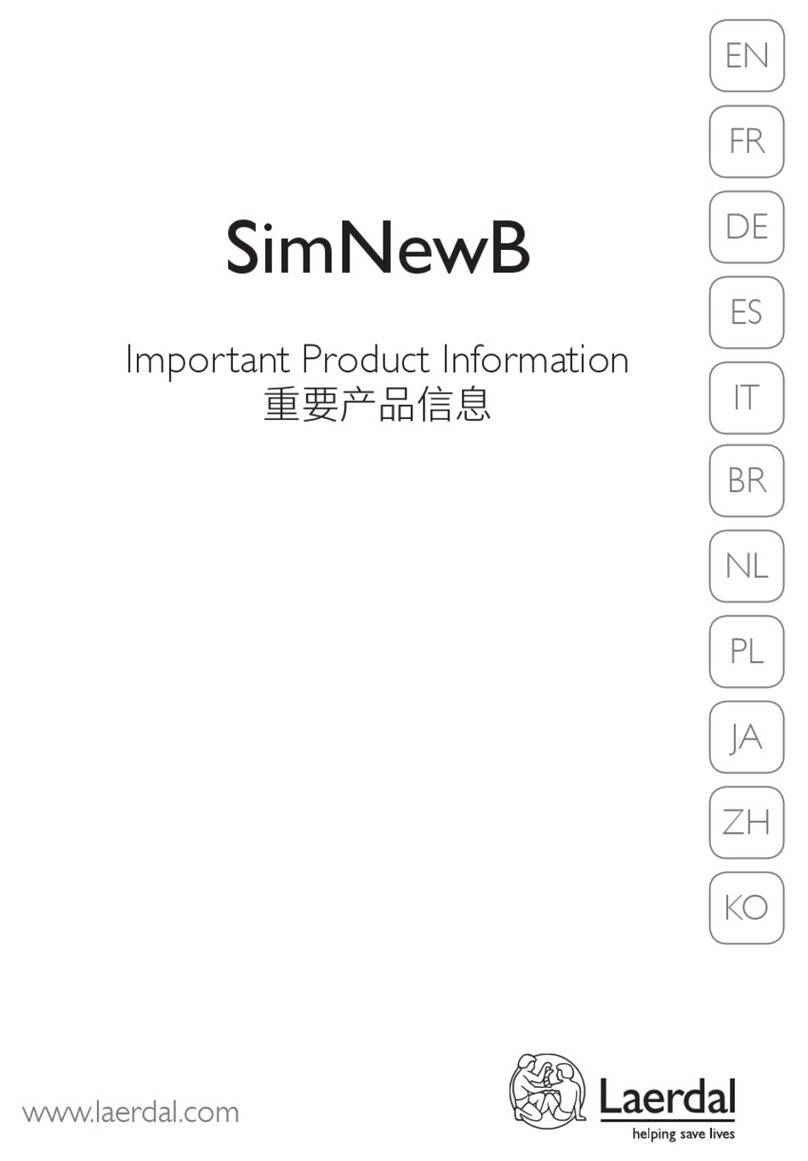
laerdal
laerdal SimNewB Important product information
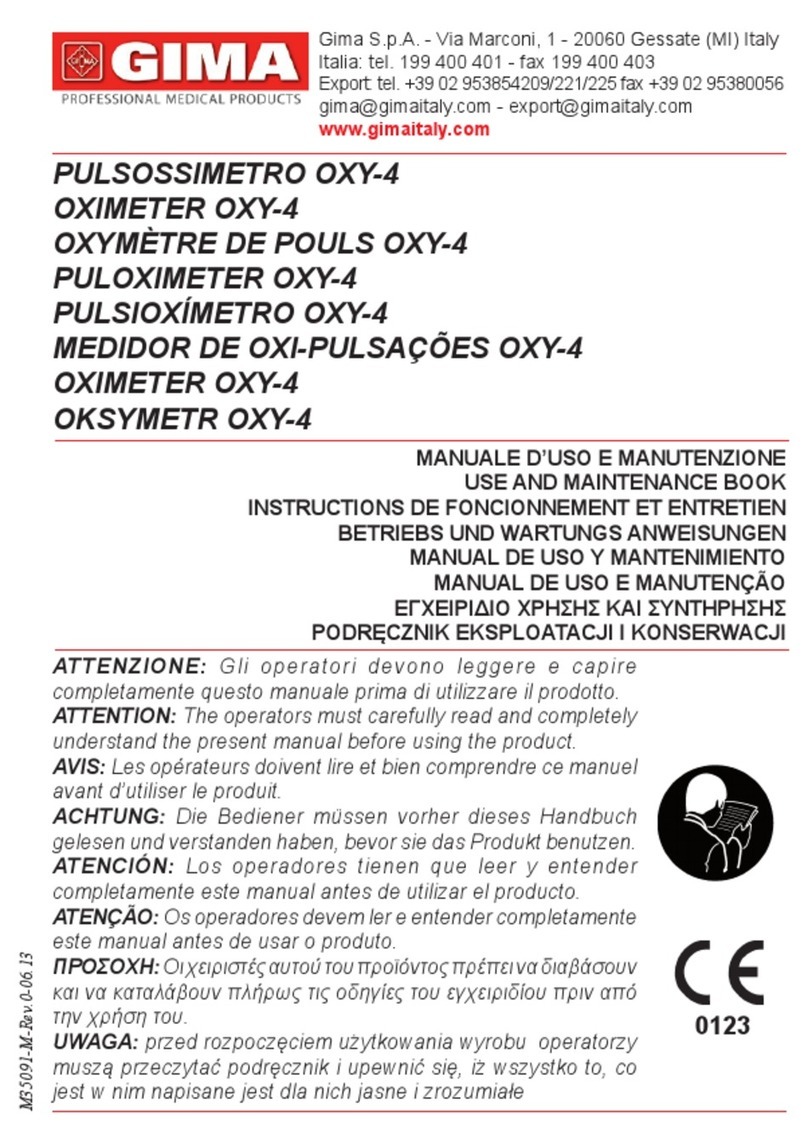
Gima
Gima OXY-4 Use and maintenance book
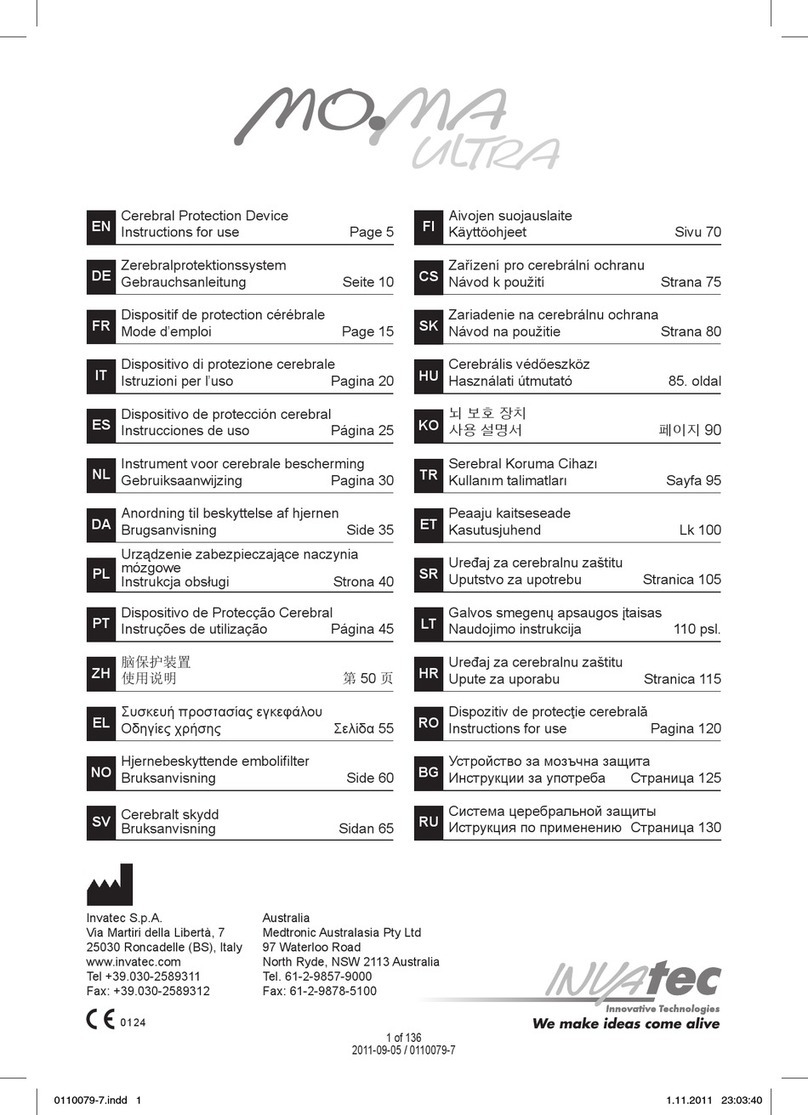
INVATEC
INVATEC Mo.Ma Ultra mono balloon Instructions for use
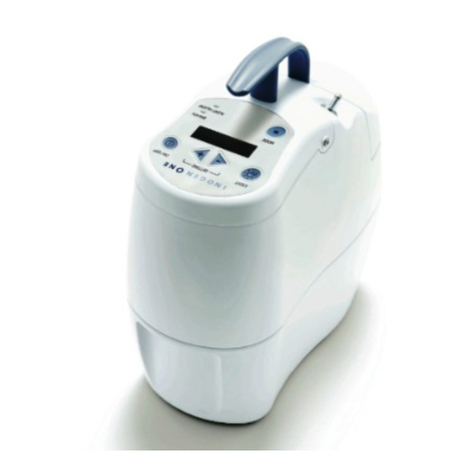
Inogen
Inogen One IO-100 Patient manual

Cegla
Cegla RC-Test COPD instructions
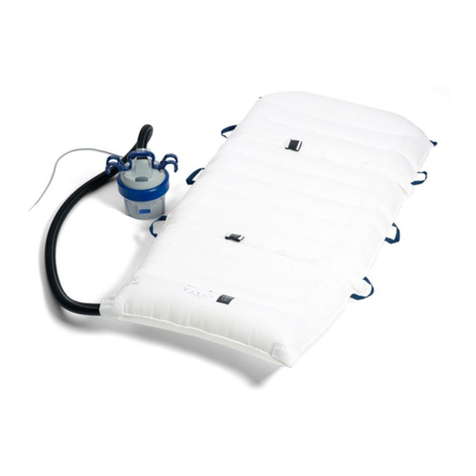
Arjo
Arjo Maxi Air Instructions for use
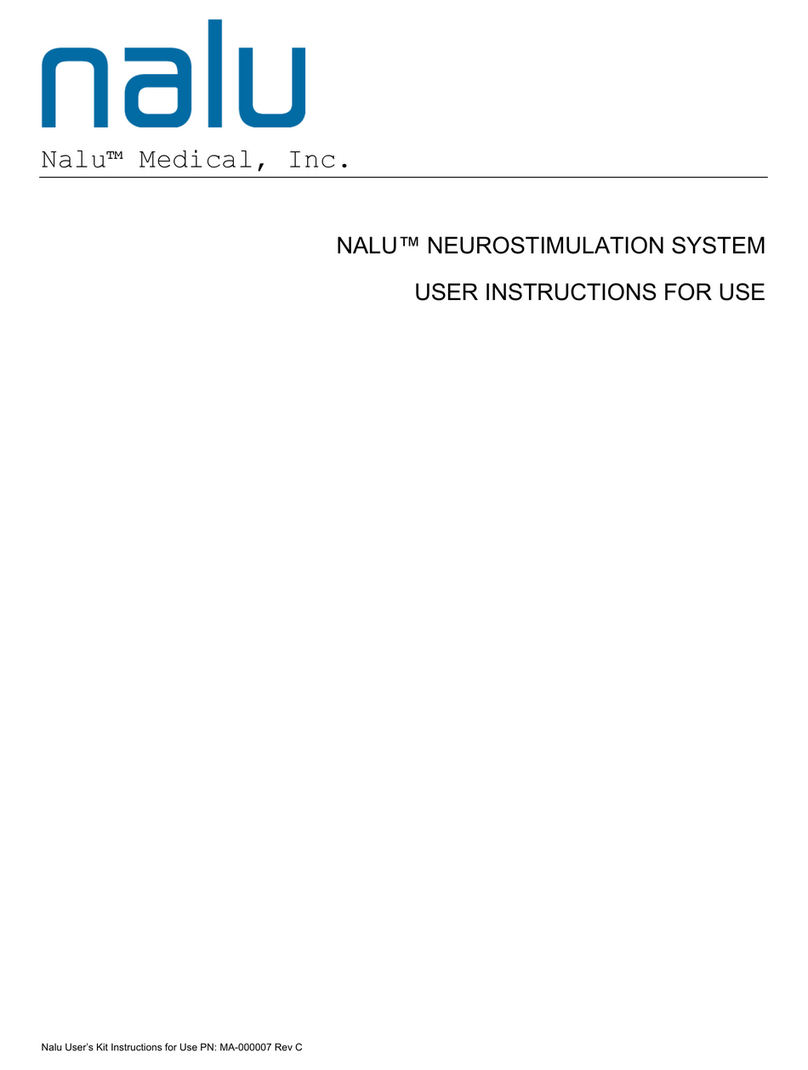
Nalu Medical
Nalu Medical Nalu Neurostimulation System User Instructions For Use

Ohio Medical
Ohio Medical Instavac I Operator and maintenance manual
